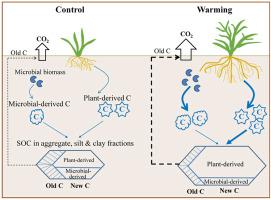Soil Biology and Biochemistry ( IF 9.7 ) Pub Date : 2020-11-18 , DOI: 10.1016/j.soilbio.2020.108074 Ruiying Chang , Shuguang Liu , Leiyi Chen , Na Li , Haijian Bing , Tao Wang , Xiaopeng Chen , Yang Li , Genxu Wang

|
Permafrost areas are experiencing fast and dramatic changes under global warming. Increased primary production and stimulated microbial activity have been widely observed in warming permafrost. However, the fate of permafrost soil organic carbon (SOC) remains elusive, and the potential mechanisms underlying warming-mediated SOC formation and old C decomposition are poorly understood. Here, using in situ six-year manipulative warming experiments with two scenarios (+2.4 °C and +4.9 °C for lower and higher scenarios, respectively, above the ambient temperature) at a permafrost site in the Tibetan Plateau, we observed that soil C sink increased in the surface 5 cm layer under the two warming scenarios. SOC exhibited a linear increase with warming duration at rates of 6.8% and 6.4% annually in the silt & clay fractions and aggregates, respectively. Warming-induced accumulations of SOC in the aggregates and silt & clay fractions were contributed mainly by plant-derived C and minorly by microbial necromass. However, the increased input of new plant-derived C was accompanied with an increasing loss of old C via enhanced respiration under warming, likely due to the mobilization and degradation of C in the aggregates and silt & clay fractions. Our study provides field-based evidence of the enhanced SOC accumulation in the Tibetan permafrost regions under warming, and improves process-based understanding of warming-induced new plant-derived C that could replace the protected old C in the aggregates and silt & clay fractions.
中文翻译:

青藏高原多年冻土区土壤有机碳变暖
在全球变暖的作用下,多年冻土地区正在经历快速而巨大的变化。在变暖的多年冻土中已广泛观察到初级生产力的提高和微生物活性的提高。然而,多年冻土土壤有机碳(SOC)的命运仍然难以捉摸,并且对由变暖介导的SOC形成和旧碳分解的潜在机制了解甚少。在这里,就地使用在青藏高原多年冻土带的两种情景下(分别为+2.4°C和+4.9°C,分别为低和高情景,分别高于环境温度)的六年操纵性变暖实验中,我们观察到土壤碳汇在在两种变暖情况下,表面厚度为5厘米。淤泥和粘土级分和骨料中的SOC随着增温持续时间呈线性增长,分别为每年6.8%和6.4%。增温引起的SOC在聚集体和粉砂和粘土组分中的积累主要由植物衍生的碳贡献,而微生物坏死微生物贡献较小。然而,新植物来源的碳的增加输入伴随着变暖导致的呼吸增强而导致的老碳损失增加,这可能是由于骨料和粉砂和粘土部分中碳的迁移和降解所致。


























 京公网安备 11010802027423号
京公网安备 11010802027423号